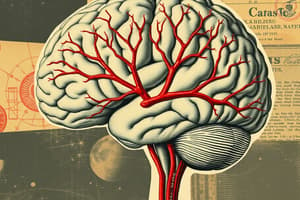Podcast
Questions and Answers
Which arteries are part of the anterior cerebral circulation?
Which arteries are part of the anterior cerebral circulation?
- Internal carotid arteries (correct)
- Vertebral arteries
- Posterior cerebral artery
- Basilar artery
Which arteries are part of the posterior cerebral circulation?
Which arteries are part of the posterior cerebral circulation?
- Basilar artery (correct)
- Internal carotid arteries
- Anterior cerebral artery
- Vertebral arteries
What is the average perfusion of blood per 100 grams of brain tissue per minute?
What is the average perfusion of blood per 100 grams of brain tissue per minute?
- 18 to 20 millilitres
- 50 to 54 millilitres (correct)
- 750 millilitres
- 8 to 10 millilitres
Which arteries supply the anterior brain?
Which arteries supply the anterior brain?
What is the typical rate of cerebral blood flow in an adult human?
What is the typical rate of cerebral blood flow in an adult human?
What do veins carry back to the heart in cerebral circulation?
What do veins carry back to the heart in cerebral circulation?
Which of the following is true about cerebral perfusion pressure (CPP)?
Which of the following is true about cerebral perfusion pressure (CPP)?
What happens to cerebral blood vessels when systemic blood pressure is raised?
What happens to cerebral blood vessels when systemic blood pressure is raised?
What is the effect of higher levels of carbon dioxide in the blood on cerebral blood vessels?
What is the effect of higher levels of carbon dioxide in the blood on cerebral blood vessels?
What is the relationship between arterial partial pressure of carbon dioxide (PaCO2) and cerebral blood flow (CBF)?
What is the relationship between arterial partial pressure of carbon dioxide (PaCO2) and cerebral blood flow (CBF)?
Flashcards
Anterior cerebral circulation
Anterior cerebral circulation
Internal carotid arteries.
Posterior cerebral circulation?
Posterior cerebral circulation?
Basilar artery.
Average brain tissue perfusion
Average brain tissue perfusion
50 to 54 milliliters.
Arteries supplying the anterior brain
Arteries supplying the anterior brain
Signup and view all the flashcards
Typical cerebral blood flow
Typical cerebral blood flow
Signup and view all the flashcards
Veins carry back what?
Veins carry back what?
Signup and view all the flashcards
Cerebral Perfusion Pressure (CPP)
Cerebral Perfusion Pressure (CPP)
Signup and view all the flashcards
Cerebral vessels under high systemic BP
Cerebral vessels under high systemic BP
Signup and view all the flashcards
Effect of high CO2 on cerebral vessels
Effect of high CO2 on cerebral vessels
Signup and view all the flashcards
PaCO2 and Cerebral Blood Flow (CBF)
PaCO2 and Cerebral Blood Flow (CBF)
Signup and view all the flashcards
Study Notes
Cerebral Circulation
- Anterior cerebral circulation involves the anterior cerebral artery and the anterior communicating artery.
- Posterior cerebral circulation involves the posterior cerebral artery and the posterior communicating artery.
Blood Supply and Flow
- Anterior brain is supplied by the anterior cerebral artery and the middle cerebral artery.
- Typical rate of cerebral blood flow in an adult human is approximately 750 mL/min.
Cerebral Blood Flow Regulation
- Cerebral perfusion pressure (CPP) is the difference between mean arterial pressure and intracranial pressure.
- When systemic blood pressure is raised, cerebral blood vessels constrict (vasoconstriction) to maintain constant blood flow.
- Higher levels of carbon dioxide in the blood cause cerebral blood vessels to dilate (vasodilation), increasing blood flow.
Cerebral Perfusion and Veins
- Veins carry deoxygenated blood back to the heart in cerebral circulation.
- Average perfusion of blood per 100 grams of brain tissue per minute is approximately 50-60 mL.
Studying That Suits You
Use AI to generate personalized quizzes and flashcards to suit your learning preferences.




